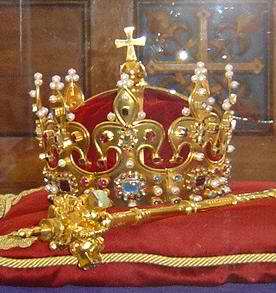 | A liliom és a história |

|
- Krisztus előtt
"Sinatruces (77-70 B.C.) AR Drachm 4.03g (PDC 23570) Mint: Rhagae Obv: bearded bust left wearing tiara (T34i) decorated on side with fleur de lys, around crest with pairs of pellets on stalks; behind bust, anchor symbol; circular border of pellets"
Az Arszakidák idején látjuk feltünni a pénzérmeken a liliom mintát. Az érem görög betüe felirata:
ΒΑΣΙΛΕΩΣ
ΜΕΓΑΛΟΥ
ΑΡΣΑΚΟΥ
ΕΥΕΡΓΕΤΟΥ
ΕΠΙΦΑΝΟΥΣ
ΦΙΛΕΛΛΗΝΟΣ
A
Fleur-de-lys eredete
Az ókor hajósai használták a napot, csillagokat, sőt még a szelet is tájékozódásukhoz a tengeren. A szélrózsának 8 fő iránya volt. Az iránytűk korai példányain szerepelt egy nyíl jelölve az északi irányt és egy "T" betü a tramontana szél jelölésére. A 15. sz.-ban a két szimbólum egyesülésével jött létre a fleur-de-lys. Ez természetesen csak egy kedves mese..
 Szimbólumok: "Már a perzsák és a szíriaiak legrégibb költeményei is
dicsőítik, hasonlóképpen a Biblia; SALAMON király híres jeruzsálemi templomában az építész liliom-alakot adott az oszlopfejeknek, a zsidók liliommal
diszítették oltáraikat. Sőt valószínű, hogy Susának, Perzsia egyik legfontosabb városának, a neve liliomban bővelkedő vidékével kapcsolatos, valamint az is, hogy a zsidó női név: Susanna (Zsuzsi), a nő tisztaságát és szemérmetességét akarja jelezni. "
Szimbólumok: "Már a perzsák és a szíriaiak legrégibb költeményei is
dicsőítik, hasonlóképpen a Biblia; SALAMON király híres jeruzsálemi templomában az építész liliom-alakot adott az oszlopfejeknek, a zsidók liliommal
diszítették oltáraikat. Sőt valószínű, hogy Susának, Perzsia egyik legfontosabb városának, a neve liliomban bővelkedő vidékével kapcsolatos, valamint az is, hogy a zsidó női név: Susanna (Zsuzsi), a nő tisztaságát és szemérmetességét akarja jelezni. "
Juno-val, az ég
királynőjével társítják a kelet egyik legszebb virágát, a fehér liliomot. A virág Perzsiából terjedt el, s a női tisztaság, szemérmesség jelképe egyben. A rómaiaknál egyben a remény virága is volt, pénzérméken előfordult a Spes populi romani (a római nép reménye) mondat.
leirion
O.E. lilie, from L. lilia, pl. of lilium "a lily," cognate with Gk. leirion, both perhaps borrowed from a corrupted pronunciation of an Egyptian word. Used in O.T. to translate Heb. shoshanna and in N.T. to translate Gk. krinon. The color sense of "pale, bloodless" led to lily-livered "cowardly" (1605, in "Macbeth;" see liver; the healthy liver is typically dark reddish-brown). The lily of the valley translates L. lilium convallium (Vulgate), a literal rendition of the Heb. term in Song of Solomon ii.1. It apparently was applied to a particular plant (Convallaria majalis) first by 16c. Ger. herbalists.
arcadia
Ellada
Miről ismerhető fel a turul?
Madár formája van... ..de az oldal érdekessége, hogy a liliom mintának speciális jelentést ad: Énlakai "eGY USTeN"
Halley
A szőnyegen számos más érdekes jelenet is látható, például itt találták meg a Halley-üstökös első ismert ábrázolását, amely abban az időben ért a legközelebb a Naphoz. A részletgazdagság, a valósághűségre törő igyekezet a mű epikus jellegét hangsúlyozza. A képeket latin nyelvű feliratsor egészíti ki. Latinul tudó megfejthetné a feliratot: "ISTIMIRANT STELLA" . Talán így?: isti mirantur stellam. Csak elírták. Más nyelvekből: Istim/kígyó iránt stella/csillag. Mondják, hogy a tapéta szász szavakat is tartalmaz.
Harold és a liliomos korona. Még a kereszt is liliom formájú.. ..de nézzétek meg
mind
A "Fleur-de-lys" (liliom) 1200 körüli
érméken
A lengyeleknél is gyakori a liliom, amely "életfa" szimbólum is egyben.
Olesko, kastélybejárat. Van itt minden.. szárnyas ember, életfa, oroszlán és kígyó...
Osztrák (Krone_Kaiser_Rudolf_II_Kaisertum_Österreich) Képsor helyett liliom-minta
The Bun and the Sun in Syria
"The reliefs on these plates appear to have been partially gilded and silvered. The first plate (fig 487) 1 represents a bearded Iupiter Dolichenus in his accustomed attitude. Close to his head is a star (possibly the planet Iupiter). A Victory with wreath and palm approaches him. Before him burns a small altar. His bull stands on a base inscribed 'To Jupiter Dolichenus' 2 and flanked by busts of Hercules with his club and Minerva with her helmet and lance. Above the main design are two panels of diminishing size: the lower one contains busts of the Sun and Moon; the upper one, a lily-plant. The second plate (fig. 488) 3 is divided into five registers. Highest up is the same lily. Then comes an eagle with spread wings."
The Merovingian king, Clovis, had the iris , or
Fleur-de lys, as his royal emblem, a flower which grows wild in the Middle East. It is also known as a three-pronged lily and it was used to symbolize Nimrod or rather the reptilian bloodline of Nimrod. In Latin it means small sword and it
became the symbol of the royal bloodline of what is now France and this was because in ancient Sumer the reptilian bloodline, as passed on trough the
female, was symbolized by a lily. Hence the main reptilian gene carriers were given names like Lilith, Lili, Lilutu and Lillette.
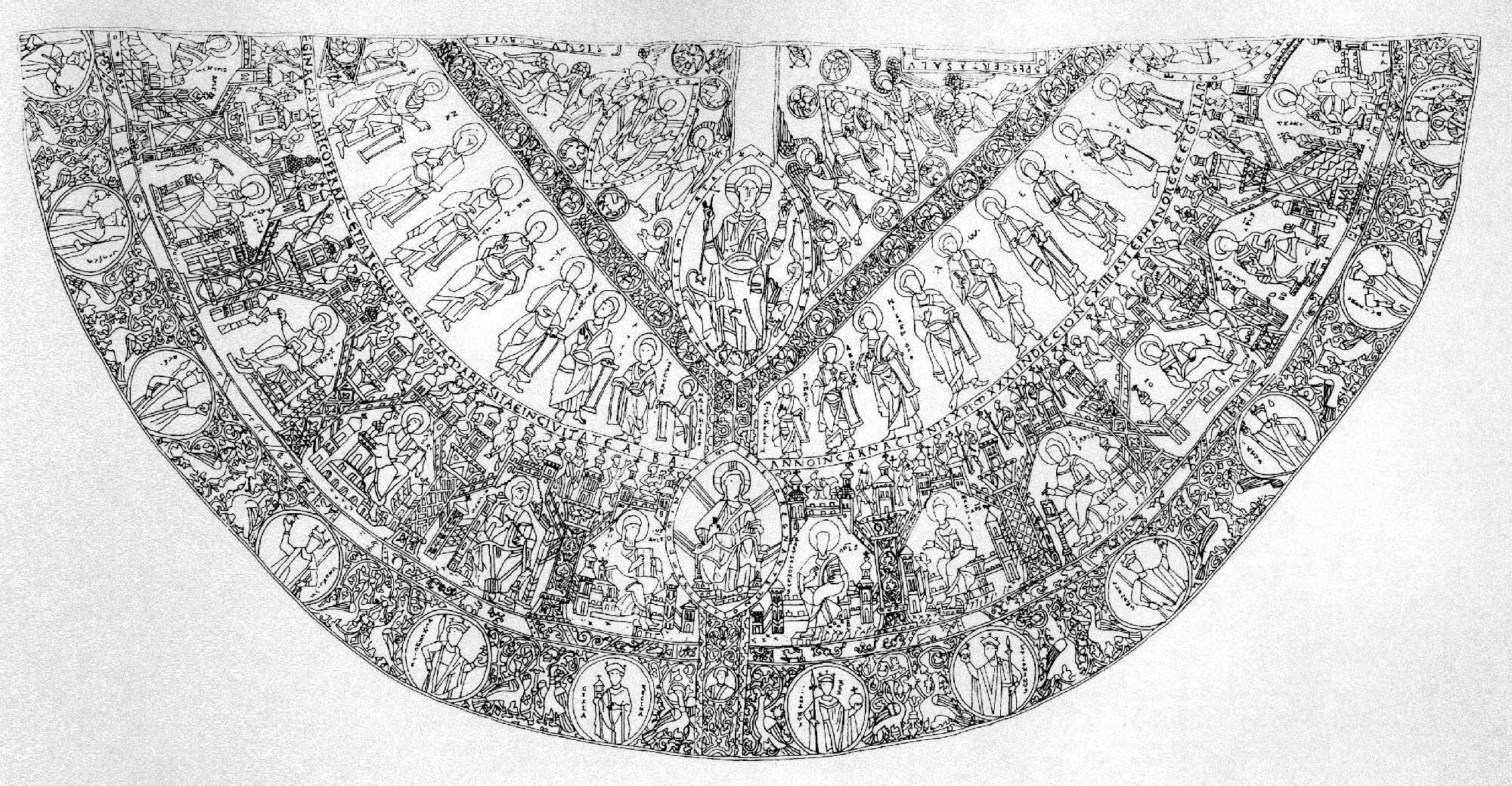
Palást
Sas-szeműek megláthatják a koronázási paláston István koronáját, amit állítólag 3 liliom díszít. Vagyis a liliom minta, ami Koreától a Loire völgyéig, az ógörög vidéktől a lengyelekig megtalálható, az már István királynál is szerepel.
Vagy Fortuna viccelődik velem, vagy valóban AD 1200 táján a liliom minta valamiért robbanás szerűen elterjedt Európában. Ugyanis e korból találtam a
legtöbb ilyen mintát.
Liliom
"Lilies have been cultivated for over 3000 years. Feng Shui believers hold the lily as an emblem of summer and abundance; to the Chinese, lily means "Forever in love". The lily was the holy flower of the ancient Assyrians. Until the 16th century the Madonna lily was the only garden variety known, because of
this the "lilies of the field" as mentioned in the bible are thought to be this specific lily. A lily has adorned the coat of arms of the kings of
France since 1179. King Chlodwig I allegedly received this fleur-de-lys, as it is called in heraldic language, from an angel. But in actual fact his flower wasn't a lily, as the name implies, but an iris.
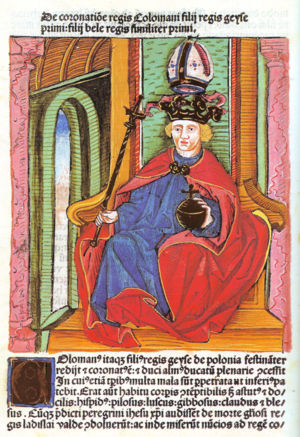 Bosnyák rokonság
Bosnyák rokonság
Fleur-de-lis
A liliom motívum megtalálható Korea egyik ősi (silla) koronáján, a Margit-szigeten talált magyar koronán, vagy "Atila" kardján. Kedvelt motívum a kazakoknál. Egyesek szerint nem is liliom, hanem stilizált irisz. ...de nézhetjük madárnak is. A Margitszigeten talált koronával az a gond, hogy egyidős az Anjou liliommal. A Silla koronája kissé öregebb...(cca. 6. c.AD.) A Kárpát medencében még egy liliomos koronát találtak 1775-ben Nagyváradon. Mária királyné koronája, bécsi múzeum.
Érdekességnek:
A tulipán a magyarok, törökök és hollandok nemzeti virága.
Az etruszk és francia kapcsolat
A Soros alapítványnál látható ez a minta
és a makedon
szőnyeg mintájában is felismerhetjük a liliomot, valamint a 12.sz.-i német-római
koronán is szerepel a liliom minta.
...om mani padme hum
"... the first containing symmetrically arranged lily heads, ... commonest motives on Syrian and North Mesopotamian seal cylinders of the Late Bronze Age. ..."
"It was used FIG . 8.— Egyptian pottery for vases, but more generally for `With painted (Lat. ornare, to adorn) ornament and small figures and scarabs (6) . The sham marbling . commonest vase-form of this period is the pilgrim bottle, now made with the neck (O. Eng. hnecca; the word appears in many Teutonic languages; cf. Dutch ride, Ger. Nacken; in O. E. the common word was heals; cf. Ger. Hals) in the form of a lily flower, and with inscriptions on the sides wishing good luck in the New Year to the possessor "
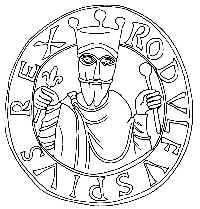 Dualizmus
Dualizmus
III. Rudolf burgundiai király (993-1032) pecsétjére, amelyen az uralkodó jobb kezében a gyakori liliomos végű, a baljában pedig gömbös végű jogart tart.
II. Fülöp francia király a 12. sz.-i érméjén nem országalmát, hanem liliomot tart a
kezében. "the design can be found in many places long before heraldic times, as far back as Mesopotamia. " It is an essentially graphic theme found on Mesopotamian cylinders, Egyptian bas-reliefs, Mycenean potteries, Sassanid textiles, Gaulish coins, Mameluk coins, Indonesian clothes, Japanese emblems and Dogon totems.
Liliom a fáraok birodalmában:
The god of the blue water lily was Nefertem, a god not just linked to the sun but to beautification and healing. It was he who brought a water lily to the sun
god Ra, to help ease the suffering of his aging body. The perfume of this flower was not only pleasing to the Egyptians, but they saw it as healing as
well.

Vizi liliom The blue lotus was found scattered over Tutankhamen's body when the Pharaoh's tomb was opened in 1922. ”. In wall paintings on Egyptian ruins you can see they really loved this flower. It's fragrant with a nice fruity scent. There are wall frescoes with Egyptians smelling the blossoms. It's even thought to be narcotic. They even infused their wine with the blossoms.
Gyula vagy torony?
"One of these alternative sources was the Temple of Gula. Gula, often envisioned in canine form, was one of the more significant gods of healing. While excavations of temples dedicated to Gula have not revealed signs that patients were housed at the temple while they were treated (as was the case with the later temples of Asclepius in Greece), these temples may have been sites for the diagnosis of illness."
Építészeti terminusok
Thera
"A representation of a pithos plant pot with lily adorned the jambs of the window in the West House"
 Kínai népmese:
Kínai népmese:
"Above, on a scroll, was written
The Cassia Court. " Mese a Liliom hercegnőről.
"It is also the emblem of the Swiss Municipality of Schlieren, Zürich." ..de mi Zürich régi neve?.. (It is first mentioned in 807 under the form "Turigus," then in 853 as "Turegus". Latinized form is Turicum)
Mary Michel Pastoureau, the historian, says that until about 1300 they were found in depictions of Jesus, but gradually they took on Marian symbolism and were associated with the Song of Solomon's "lily among thorns" (lilium inter spinas), understood as a reference to Mary.
Az éjszaka démona: Lilith The figure of Lilith first appeared in a class of wind and storm demons or spirits as Lilitu, in Sumer, circa 4000 BC.

Shushan A liliom városa - Susa (meg a lovaké..)
"The city name is derived from Shashana, a member of water lily family of flowers, believed to grow in lakes and swamps outside this biblical city in ancient times. Susa was the capital of a ancient kingdom know is Elam."
Babilonians
"Every one carries a seal, and a walking stick, carved at the top into the form of an apple, a rose, a lily, an eagle, or something similar; for
it is not their habit to use a stick without an ornament (Her., I. 195)."
Susa Susa is one of the oldest known settlements of the region, probably founded
about 4000 BC, though the first traces of an inhabited village date back to 7000 BC. Evidence of a painted pottery civilization dates back to 5000 BC. In
historic times, it was the capital of the Elamite Empire. Its name originates from their language; it was written variously (Shushan, Shushun etc.) and was
apparently pronounced Susan. Shushan was invaded by both Babylonian empires as well as the Assyrian Empire in violent campaigns. After the Babylonian conquest, the name was misunderstood to be connected with the Semitic word Shushan, "lily".
Nape is what the water lily, Nymphaea alba, is called by local people in Peten" /A tájon még ma is él a hajnal szavunk./
Maya vallás
"Cama Zotz, the one that kill the Hero twin Hunahpú in the Bat House, being Ah Puch, the God of the Death in the lower level. East (lak'in) is the direction of sunrise, associated with red (chak), the color of dawn. West
(chik'in) is the direction of sunset; its color is black (ek'). North (xaman) is white (sak). The color of the south (nohol) is yellow (k'an). Green (yax) is the color of the center, of the green ceiba tree (yax´che´), representing the great World Tree"
Maya The Popol Vuh god called Feathered Serpent was identified with sheet lightning
and was parallel to the Waterlily Bird Serpent found in Maya art, and Vak’ (the laughing falcon of the Popol Vuh) was parallel to the Principal Bird Deity of
the Classic Period
A vizi liliom Egyiptom területén volt divatos.

Liliom
Ez magyarázza, amit Csoma még különösnek talált, hogy az
Anjou-liliomot, mint címert csak a Győr-nemzetség leszármazói használták középkori heraldikánkban, „s Anjou királyaink alatt is csak azok, kiknek ők, mint saját címerüket különös királyi kegyből adományozták... Későbbi heraldikánkban is ritkán kért és ritkán adományozott címerkép. Csak Kassa város nemesített polgárainak címereiben látjuk, mint emlékeztetőt szülővárosukra, családuk bölcsőjére, mely azt még 1369-ben kapta különös
királyi kitüntetés jeléül címerébe Nagy Lajos királytól.”
Ha körülnézünk a franciák liliomos területén (Loire völgy, Turán), akkor bizony a Győr szó is áthallatszik az egyik folyó nevében..
Óbuda
A háromszögpajzson, kék mezőben, Erzsébet királynénak, Nagy Lajos királyunk anyjának vára látható, az eredeti ábrához hűen. A vár alapjait századunk
folyamán a Kálvin közben hozták felszínre a régészeti kutatások. A címerábrán a feketekapus, ezüst várfal mögött középen torony magasodik, melynek jobb és bal oldalához tükörképszerűen egy-egy kétablakos, cseréptetős épület támaszkodik. Mázuk szintén ezüst. Fölöttük, a toronytól jobbra az Anjou címer látható:
háromszög alakú hasítással osztott pajzs, jobbról vörössel és ezüsttel hétszer vágott mezővel, - vagyis az árpádsávokkal, utalva az Anjouk rokonságára az árpád házzal -, balról kék mezőben ábrázolt arany Anjou-liliomokkal. Fölötte arany Anjou-liliom lebeg. A vártoronytól balra, szintén háromszögpajzson, vörös mezőben az ezüst Piast-sas látható, utalva arra, hogy Erzsébet királyné a lengyel uralkodóházból származott. A pajzs fölött a benne szereplő ezüst sas kisebb változata áll. " 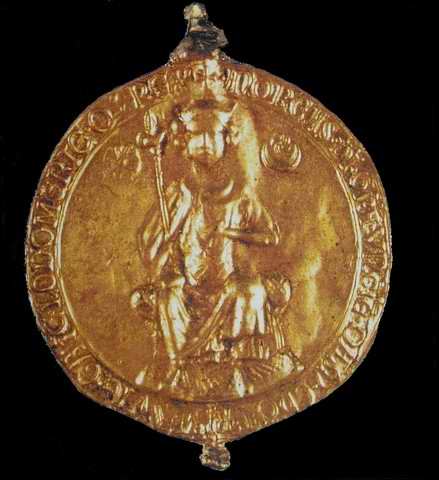
A burgund címer hasonlóképpen vörös pajzson ezüst madár..
A finneknek nem volt királya. Azért a címerükön a korona liliomos. Liliomos a magyar Aranybulla pecsétje (az Anjou-k előtt!) és a történelmi atlaszban szereplő pápai tiara is liliom mintás.
Forint
"Az első Anjou királyunk gazdasági intézkedései során bevezette pénzrendszerünkbe az Arany Forintot. Ennek első típusán a Firenzei Liliomot ábrázoltak, ami annyiban különbözött az Anjoutól, hogy a porzókat is tartalmazta."
Szimbólumok
"I.István vörös zászlaján I.András uralkodása (1046-1060) idején fehér kereszt (III.Béla korában kettős kereszt) jelent meg, majd Imre uralkodásától (1196-1204) kezdve elterjedt az un. Árpád-sávos (vörös-fehér) zászló. Ezt megtartották a vegyes házi királyok is (1526-ig) , de kiegészítették saját jelképeikkel (pl. az Anjou liliommal, vagy a Hunyadiak hollójával ). A magyar zászlón a XVII. században jelent meg harmadik színként a zöld (az első ilyen zászlót III.Mehmed szultán adományozta Báthory Zsigmondnak 1601-ben " (Viszont állítólag már az Aranybullán
piros-fehér-zöld zsinór volt.)
Kréta
"The Prince of Lilies is from one of the large frescoes at the palace of Knossos. The fresco demonstrates the fluidity of movement and naturalism of Minoan art between 1700 and 1400 BCE."
Susa
"According to Hehn, roses and lilies entered Greece from the east by way of Phrygia, Thrace and Macedonia (Kulturpflanzen and Hausthiere, 3rd ed., p. 217). The word Xeipcov itself, from which lilium is derived by assimilation of consonants, appears to be Eranian (Ibid. p. 527), and according to ancient etymologists (Lagarde, Ges. Abh. p. 227) the town of Susa was connected with the Persian name of the lily susan (Gr. vouvov, Heb. shoshan)."
Japán
"YURI, the Japanese word for depicting lily, comes from the old Japanese word YURU that means "swing". It seems that ancient people named the plant after the sight of its flowers swinging in the wind. The Japanese often use YURI as a girl's name, and sometimes add SA to become SAYURI. This SA means "sacred" in old Japanese. Lilies were sacred plants in ancient times. There is a festival called SAIKUSA MATSURI (SAIKUSA = old name of SASAYURI, Lilium japonicum, MATSURI = festival) in Nara Prefecture."

Ez a YURI engem a győri-re emlékeztet...
Az élet fája "The fleur de lis traces its origins back to the sacred lotus symbol for "plant" meaning "Tree of Life"."
Ismétlem: A
liliom minta előfordul már a Sassanida birodalomban, megtaláljuk Silla területén, a lengyeleknél, a svédeknél, a skótoknál, a frankoknál, az osztrákoknál de még a római teületen is. (A linken Taiwan szigetéről egy fametszet.) Általában a hun területeken.
'Kalasha Moon' (Kalasha Language) Afternoon School
The Kalash (Nuristani: Kasivo) or Kalasha, are indigenous people of the Hindu Kush The room where the kalash is established is called 'Dashain Ghar'.
Anjou Liliomos
the ritualistic metal pot (kalash)
Kalap =
Moon
Kalash = sacred urn.
Liliom
Legenda
Early representations of the lily were discovered in a villa in Amnisos,Crete, which dates from the Minoan Period, about 1580 B.C. The lily was the Minoan sacred flower, a special attribute of the Great Minoan Goddess Britomartis or Dictynna who had her origin in Neolithic times. She maintained her supremacy in Crete until the mysterious cataclysm that befell Minoan civilization in the middle of the sixteenth century B.C. when her cult was gradually assimilated into the religion of the Greeks and she became the precursor of Greek Artemis.
Sötét oldal
Lily is prized by diverse cultures as an emblem of purity, innocence, and virginity. The flowers were said to have sprang from the milk of the Greek Goddess Hera, and associated to Artemis and Diana. Lilies are also sacred to the Virgin Mary; many medieval paintings show her with lilies.
Francia liliom
Fleur de lis was adopted by King Phillip I of France or King Louis VI who became the first French monarch to use the Fleur de lis on his shield. (A blue shield decorated with golden Fleur de lis). As Louis VIII wore blue vestments decorated with golden fleur de lis, English kings added the symbol on their coat of arms to emphasize their claims to the French throne.
Potnia
In Mycenaean monuments, Potnia appears with many attributes: the snakes, the double axes, the lions, the doves, the griffin, as well as other kinds of animals and sacred features. Sometimes standing alone they have to indicate the presence of the goddess.
Holdistennő
Dione/Nemorensis/Nemetona ~Goddess of the Moon-grove~ (Greece, Rome)
Holdvirágok: acanthus, convolvulus, geranium, lily, water lily, white rose, (also many night blooming flowers, water related flowers, & night-blooming white tropical flowers, any white flowers)
Kréta
Mallia (from Omalia) is located some 36 km east of Heraklion, near the coast where there used to be a small natural harbour. Some sources contend that the Minoan name for the area was Milatos and that the local king was Sarpedon, son of Zeus and Europa, and younger brother of Minos because it was the third-largest palace (7,500 sq.m) after Knossos and Phaistos, the seats -
respectively - of Minos and Rhadamanthys.
Bird
The name "Potnia" or "po-ti-ni-ja," "The Lady," has survived inscribed on tablets at Knossos, along with the epithet "a-ta-na," which is very likely an early version of the titular Athene. It is possible that this name was associated with the domestic goddess, for despite the typical classical view of Athene as a warrior divinity, she was such in defense of the city. She was a weaving goddess, a goddess of the temple flame and of inventions that benefited civilization. The word "a-ta-na" has also been postulated to mean "hearth pan." The Athene who bears the owl, snake and figure-eight shield of the Minoans is
very likely one form of the early Minoan Great Goddess.
Key among that art are bird images in ceramic and ivory, and a small ivory and gold statue of a kouros, the young god -- here likely a sky-focused god, perhaps the Cretan Zeus Welkanhos, more Orion than All-Father.
Érdekességnek: - Haghia Triada
Cretan gloss βριτύ with Greek γλυκύ 'sweet'. ..és akkor a brithon az "édes otthon"
?
Su-māru: Tűzfiak? The second part of the compound, -marti-, is contrastingly sourceable to Assyrian mārtu 'daughter, girl', a purely Semitic feminine form of māru 'son, boy'.
Babylonian Brotherhood of reptile-Aryan priests and ‘royalty’ which came together there after the flood.
Pesti István 2009.jan.




 Szimbólumok: "Már a perzsák és a szíriaiak legrégibb költeményei is
dicsőítik, hasonlóképpen a Biblia; SALAMON király híres jeruzsálemi templomában az építész liliom-alakot adott az oszlopfejeknek, a zsidók liliommal
diszítették oltáraikat. Sőt valószínű, hogy Susának, Perzsia egyik legfontosabb városának, a neve liliomban bővelkedő vidékével kapcsolatos, valamint az is, hogy a zsidó női név: Susanna (Zsuzsi), a nő tisztaságát és szemérmetességét akarja jelezni. "
Szimbólumok: "Már a perzsák és a szíriaiak legrégibb költeményei is
dicsőítik, hasonlóképpen a Biblia; SALAMON király híres jeruzsálemi templomában az építész liliom-alakot adott az oszlopfejeknek, a zsidók liliommal
diszítették oltáraikat. Sőt valószínű, hogy Susának, Perzsia egyik legfontosabb városának, a neve liliomban bővelkedő vidékével kapcsolatos, valamint az is, hogy a zsidó női név: Susanna (Zsuzsi), a nő tisztaságát és szemérmetességét akarja jelezni. "
 Bosnyák rokonság
Bosnyák rokonság  Dualizmus
Dualizmus
 Kínai népmese:
Kínai népmese:


